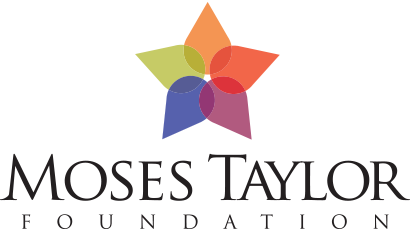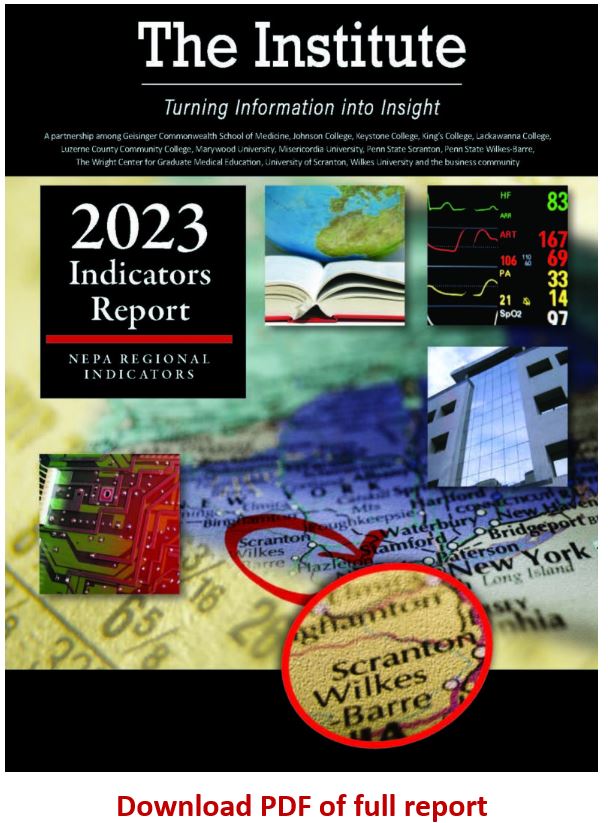Thank You
Thank you to the following organizations for their continued support of our research and this Data Dashboard, which is part of Project STIR (Sparking Transformation using Information & Research).
Cancer & Heart Disease
Cancer
Lackawanna, Luzerne, and Wayne Counties have reported fluctuating cancer death rates in recent years, while the cancer death rate in Pennsylvania has been generally declining. However, from 2019 to 2020, the cancer death rate in Pennsylvania slightly increased. Over the years analyzed, the annual average number of deaths by cancer has been 174.3 in Lackawanna County, 172.4 in Luzerne County, and 168.1 in Wayne County, exceeding the annual average rate of 163.1 in the Commonwealth. There was an uptick in the cancer death rate in Lackawanna County (to 162.9) in 2020. Similarly, Luzerne County’s rate increased from 166.4 to 166.7. Wayne County had a sharp increase in the cancer death rate in 2020 (to 187.8), a notable difference between the state and the other two counties’ rates. In the previous year, Wayne County had the lowest cancer death rate among the three counties.
Heart Disease
Pennsylvania’s age-adjusted rate of death by heart disease has seen a generally declining trend, but in the past year the state experienced more of these deaths. Lackawanna, Luzerne, and Wayne Counties have reported fluctuating rates of death by heart disease in more recent years. The statewide heart disease death rate was four percent higher in 2020 than it was in 2012. Both Lackawanna and Luzerne Counties’ heart disease death rates increased in 2020, and Luzerne County’s rate was seven percent higher than it was in 2012. Despite the recent fluctuations, rates in both geographies remain significantly above the state rate of death by heart disease. The heart disease death rate saw a decline in Wayne County in 2020. It was 23 percent lower than the rate in 2012. In that year, Wayne County’s rate fell below the state rate of death by heart disease for the first time in the period analyzed.
Cancer Deaths (Age Adjusted Rate per 100,000)
Source: Pennsylvania Department of Health
Heart Disease Deaths (Age Adjusted Rate per 100,000)
Source: Pennsylvania Department of Health
Obesity
There was a slight uptick in the adult obesity rate (to 33 percent) in the region encompassing Lackawanna, Luzerne, and Wyoming Counties, while the rate in Pike, Monroe, Susquehanna, and Wayne Counties decreased slightly to 34 percent. Pennsylvania has remained at the rate of 32 percent from 2017 through 2020 but that number increased to 33 percent for the most recent three-year time period. Over the entire period analyzed, the average adult obesity rate was 31 percent in the three-county region, 34 percent in the four-county region, and 32 percent statewide.
Adult Obesity Rate (BMI > 30.0)
Source: Pennsylvania Department of Health
| 2014-2016 | 2015-2017 | 2016-2018 | 2017-2019 | 2018-2020 | 2019-2021 | |
|---|---|---|---|---|---|---|
| Lackawanna, Luzerne, and Wyoming | 30% | 30% | 30% | 29% | 32% | 33% |
| Pike, Monroe, Susquehanna, and Wayne | 33% | 33% | 35% | 35% | 35% | 34% |
| Pennsylvania | 30% | 31% | 31% | 32% | 32% | 33% |
Infant Mortality
Infant mortality rates have fluctuated somewhat over the last decade. The rate for Lackawanna County is now below and the statewide rate and the rate for Luzerne County is above the statewide rate. Data for Wayne County was not available. The statewide infant mortality rate (measured per 1,000 live births) has declined slowly since 2014-2016, reaching 5.8 in 2018-2020. The rate in Lackawanna County also reached the lowest point over the period analyzed. The infant mortality rate in Luzerne County had increased for several years prior to the 2016-2018 period, before dropping in 2017-2019 and reaching its highest rate during the last period analyzed.
Infant Mortality Rate (per 1,000 Live Births)
Source: Pennsylvania Department of Health
Death Rate of Children Under Five
As with the infant mortality rate, the death rate of children under five years has been slowly declining statewide. It reached its lowest point over the past decade, with the rate of 125.0 in 2020. The rates in both Lackawanna and Luzerne Counties have fluctuated over the period from 2011 to 2020. While the death rate of children under five years in Lackawanna County decreased in 2020, the rate in Luzerne County rose above the statewide rate. Data for Wayne County was not available.
Rate of Death of Children Younger Than 5
Source: Pennsylvania Department of Health
Childhood Lead Screening
Pennsylvania does not require universal testing of children for elevated lead levels; tests are only mandated for children covered by Medicaid. In 2020, the number of children younger than 72 months with tested blood lead levels (BLL) higher than five micrograms per deciliter totaled 419 for the three counties combined. The share of tested children with elevated BLL in Lackawanna County (eight percent) has declined considerably since 2017, although it continues to exceed the rates in Luzerne County (seven percent), Wayne County (four percent), and statewide (five percent).
Nearly 18 percent of children in this age group were tested statewide. The percent of children tested in Luzerne County has followed statewide trends since 2017. Lackawanna County continues to trail statewide and Luzerne County testing rates, with less than 14 percent of children in this age group tested in 2020. In recent years, the percent of children tested in Wayne County is larger than the proportions in the two other counties and statewide, reaching 23.8 percent in 2020.
Percent of Tested with Elevated BLL
Source: Pennsylvania Department of Health
Suicide Rate
In 2020, the age-adjusted suicide rate in Lackawanna County declined to 12.1, after reaching a peak of 25.0 in 2018. The rate in Luzerne County has declined noticeably since 2017 to the most recent rate of 15.7. By 2019, the rate in Wayne County reached a peak of 34.4 before dropping to 23.6 the following year – this is the highest rate compared to the other two counties and statewide. The rates in Luzerne and Wayne Counties have exceeded the statewide rate for all years analyzed, while Lackawanna County’s rate was in line with the statewide rate in 2019 and 2020, following fluctuations in prior years.
Suicide Deaths (Age Adjusted Rate per 100,000)
Source: Pennsylvania Department of Health
Alcohol and Tobacco
Many chronic health conditions are linked with related health factors such as behaviors and lifestyles. Smoking and alcohol use are associated with heart disease, cancer, and high blood pressure – among other issues. Both factors analyzed here have been more prevalent in the three-county area (Lackawanna, Luzerne, and Wyoming Counties) than in the four-county area (Pike, Monroe, Susquehanna, and Wayne Counties) and the Commonwealth as a whole for the majority of periods.
The rate of cigarette smoking in Lackawanna, Luzerne, and Wyoming Counties decreased to 20 percent in 2019-2021, following a decrease in the prior period. In the four-county region including Pike, Monroe, Susquehanna, and Wayne Counties, the rate of cigarette smoking decreased to 17 percent, following an increase in 2018-2020. Both regions have consistently had high proportions of adult cigarette smokers compared with the Commonwealth as a whole – 23 percent in the three-county region and 21 percent in the four-county region compared with 18 percent statewide – over the period from 2014 to 2021.
Two measures are used for the adult population engaging in potentially harmful alcohol use. Chronic drinking is defined as consuming an average of two or more drinks every day for 30 days. Across a majority of the periods analyzed, Pennsylvania’s rate of chronic drinking has stood at six percent. It has risen slightly to seven percent, however. The three-county region’s rate of chronic drinking was higher than the statewide rate from 2016 to 2020, peaking at nine percent most recently. In the four-county region that includes Pike, Monroe, Susquehanna, and Wayne Counties, the rate of chronic drinking has been lower in the past few years compared to the other two regions. It decreased to four percent in 2019-2021.
Binge drinking is defined as the consumption of five or more alcoholic drinks for men or four or more alcoholic drinks for women on one occasion. Compared to chronic drinking, larger shares of adults regionally and statewide report alcohol use in this category. The shares are 15 percent in the four-county region and 16 percent both in the three-county region and statewide.
Adult Tobacco Smoking
Source: Pennsylvania Department of Health
Chronic Drinking
Source: Pennsylvania Department of Health
Binge Drinking
Source: Pennsylvania Department of Health
Substance Abuse
As of 2020, there were an estimated 16,086 individuals with a drug use disorder in the three-county region. Drug use disorder is defined as any substance use disorder not including alcohol use disorder. The proportion of these individuals residing in Luzerne County grew by nine percent from 2019 to 2020, while the proportion residing in Lackawanna County fell by six percent. The number of drug use disorders in Wayne County has fluctuated substantially, most recently decreasing by 54 percent.
COVID-19 appears to have affected drug overdose deaths. In 2020, there was a 42-percent increase in drug overdose deaths in Lackawanna County and a 26-percent increase in Luzerne County. In Wayne County, however, drug overdose deaths decreased by 21 percent. Statewide, drug overdose deaths grew by 15 percent, reaching the highest level seen since 2017. From 2020 to 2021, drug overdose deaths rose from 92 to 106 in Lackawanna County, from 169 to 194 in Luzerne County, and from 15 to 18 in Wayne County.
Fentanyl has typically been the drug most commonly associated with overdose deaths in Pennsylvania, having been reported in 70 percent of cases as of 2018. It was followed by heroin, cocaine, and benzodiazepines.
Abuse of opioid drugs such as fentanyl and heroin sometimes begins with abuse of prescription opioids. In recent years, the rate of opioid prescription has decreased annually in all four regions. Despite the increase in drug overdose deaths in 2020 for Lackawanna and Luzerne Counties, the pandemic did not seem to interrupt the decline in opioid dispensing. From 2019 to 2020, there was a ten-percent dispensation decline in Lackawanna County, a three-percent decline in Luzerne County, and an eight percent decrease statewide. Wayne County experienced a 21 percent decrease in drug overdose deaths in 2020 and a one percent drop in opioid dispensation from 2019 to 2020.
Drug Overdose Deaths (Any Drug, Accidental and Undetermined)
Source: PA Department of Health, via PA OpenData. Prior year data has been updated.
Opioid Prescribing Rate (per 100 people)
Source: Centers for Disease Control and Prevention. Prior year data has been updated.
Hospitals
There are 14 hospitals in Lackawanna, Luzerne, and Wayne Counties, including general hospitals, specialty hospitals, and federal hospitals. Among them, the daily room rate for a private room is $2,751 in Lackawanna County, $2,525 in Luzerne County, and $730 in Wayne County. In the three areas, the rate has grown substantially over the years analyzed. This includes an increase of 15 percent in daily rate for a private room in Lackawanna County from 2020 to 2021, though Luzerne County saw the first decline reported among the years analyzed.
The number of general hospital beds in proportion to the population has remained relatively consistent in the three counties, with 2.8 beds per 1,000 residents in Lackawanna County, 2.7 beds per 1,000 residents in Luzerne County, and 2.1 beds per 1,000 residents in Wayne County.
The COVID-19 pandemic affected use of health care services. Emergency room visits declined 23 percent in Lackawanna County between 2018 and 2020, before increasing by 14 percent in 2021. Emergency room visits in Luzerne County have fluctuated from 2017 to 2021 but were also at their lowest level in 2020. In Wayne County, emergency room visits fell by 17 percent from 2019 to 2020 before rebounding by eight percent in 2021.
Since 2020, there has been an uptick in the percentage of ER visits resulting in inpatient admission. Though this rate is not an exact indicator of ER overutilization, this trend may suggest that ER visits for non-emergent cases has been an ongoing issue in the region, with some progress being made. In 2020, the three counties saw large decreases in emergency room visits but increases in ER inpatient admission rates. This is likely due to many patients with less urgent concerns avoiding hospitals during the pandemic.
Hospitals
Source: Pennsylvania Department of Health
| Total Hospitals | Beds Per 1,000 | |
|---|---|---|
| Lackawanna | 5 | 2.8 |
| Luzerne | 7 | 2.7 |
| Wayne | 2 | 2.1 |
Emergency Room Visits
Source: Pennsylvania Department of Health
Total hospitals and daily room rate includes general hospitals, specialty hospitals, and federal hospitals. Licensed beds, beds per 1,000, and ER visit data includes only general acute care hospitals.
Long Term Care Facilities
The number of nursing homes in Pennsylvania has shown a slow decreasing trend since 2017, though they’ve remained stable in Lackawanna, Luzerne, and Wayne Counties. Numbers of beds per 1,000 residents aged 65 years and older have declined in the three counties and statewide in the most recent period. Lackawanna and Luzerne Counties have more beds per 1,000 seniors than the state overall. The three long term care facilities in Wayne County have fewer beds per 1,000 seniors than in the other three regions in all years analyzed.
The daily room rates at long-term care facilities in Lackawanna and Wayne Counties are lower than rates statewide and in Luzerne County. In addition, the rates in Lackawanna County have increased four percent since 2017-2018, compared to upticks of nearly five percent in Luzerne County and one percent statewide. Wayne County has the lowest room rates, but the largest increases in those rates (11.4 percent).
Long Term Care Facilities
Source: Pennsylvania Department of Health
| Nursing Homes | Beds Per 1,000 | |
|---|---|---|
| Lackawanna | 18 | 54.4 |
| Luzerne | 25 | 42.4 |
| Wayne | 3 | 29.7 |
| Pennsylvania | 692 | 35.2 |
Teen Pregnancy
Over the decade analyzed, Pennsylvania reported generally decreasing rates of teen pregnancies. Teen pregnancies are defined here as pregnancies among females aged 15 to 17 years old.
Declines from 2011 to 2020 include a 55-percent drop in the rate of teen pregnancy in Lackawanna County and a 40-percent drop in Luzerne County. The statewide rate has declined as well over the past decade. In recent years, Luzerne County has had a teen pregnancy rate significantly higher than the statewide rate. Data for Wayne County during the last nine years was not available, but in 2011 the county had a teen pregnancy rate lower than the other two counties and statewide.
Teen Pregnancy Rate (crude rate per 1,000)
Source: Pennsylvania Department of Health
Health Insurance Coverage
Until 2019, all four geographies experienced declines in their shares of residents covered by private health insurance, a trend that was more prominent in the region than statewide. The shares of those covered by public health insurance grew substantially regionally and in Pennsylvania since 2010, an effect of Pennsylvania’s expansion of Medicaid under the Affordable Care Act.
More recently – from 2019 to 2021, not accounting for 2020 data – the state and Lackawanna County saw slight increases in their shares of people with health insurance. In that same period Luzerne and Wayne counties experienced declines in coverage. Although 2020 data for Lackawanna and Luzerne Counties was not available, statewide data showed a further decline, with the uninsured rate decreasing to 5.5 percent, and over four percent for children.
Enrollment in health plans offered through the Healthcare.gov marketplace continued to decline regionally and statewide as of 2020. County-wide enrollment data was not available for 2021 and 2022. The share of Lackawanna County enrollees declined by six percent since 2018, while shares of enrollees declined 11 percent in Luzerne County, 12 percent in Wayne County, and 15 percent statewide. The statewide rollout of Pennie, Pennsylvania’s health insurance marketplace, occurred in 2021. According to the data published, statewide enrollment grew in 2021 and 2022 compared to prior years, reversing the declining trend.
The number of people enrolled in HealthChoices, the managed care program for Pennsylvania’s Medical Assistance recipients, has increased 29 percent statewide since 2018 and by even more significant margins in Lackawanna and Luzerne Counties. In Wayne County, the number of people enrolled in HealthChoices has increased by 24 percent since 2018. There were over 165,000 enrollees in HealthChoices in the three counties combined, representing nearly six percent of the statewide enrollment.
Percentage With No Health Insurance Coverage
Source: U.S. Census Bureau American Community Survey








 Sarah, a former Institute intern, joined The Institute in April 2021 as a Research Assistant. She started her new role as a Research Analyst in January 2024.
Sarah, a former Institute intern, joined The Institute in April 2021 as a Research Assistant. She started her new role as a Research Analyst in January 2024. 

 Jill Avery-Stoss joined The Institute in June 2018 to fill the newly-created role of Research, Data, Intern & Administrative Coordinator. She assists with the collection and management of data for purposes of ethical and efficient analysis. She visits partner campuses to market The Institute’s internship opportunities, and participates in event-planning logistical activities as well. In 2021, Jill was promoted to Director of Operations to reflect the diversity in her job description and the additional marketing and communication functions she successfully mastered in 2020. In 2022, Jill was named Chief Operating Officer after expanding into both research and administrative management functions. Jill is taking on project management, fundraising, and other executive leadership functions of the organization.
Jill Avery-Stoss joined The Institute in June 2018 to fill the newly-created role of Research, Data, Intern & Administrative Coordinator. She assists with the collection and management of data for purposes of ethical and efficient analysis. She visits partner campuses to market The Institute’s internship opportunities, and participates in event-planning logistical activities as well. In 2021, Jill was promoted to Director of Operations to reflect the diversity in her job description and the additional marketing and communication functions she successfully mastered in 2020. In 2022, Jill was named Chief Operating Officer after expanding into both research and administrative management functions. Jill is taking on project management, fundraising, and other executive leadership functions of the organization. Ooms is responsible for all facets of research, organizational strategy, and management. Ooms is an active principal investigator in all Institute research. Ooms has been nationally recognized as a leader in regional economic development. She turned that skill into a research institute to help other regions develop and prosper. Her strategic skills have allowed The Institute to expand its services to the private and non-profit sectors for research and analysis in community health needs assessments, strategic planning, market and feasibility studies, and economic impact analysis.
Ooms is responsible for all facets of research, organizational strategy, and management. Ooms is an active principal investigator in all Institute research. Ooms has been nationally recognized as a leader in regional economic development. She turned that skill into a research institute to help other regions develop and prosper. Her strategic skills have allowed The Institute to expand its services to the private and non-profit sectors for research and analysis in community health needs assessments, strategic planning, market and feasibility studies, and economic impact analysis.